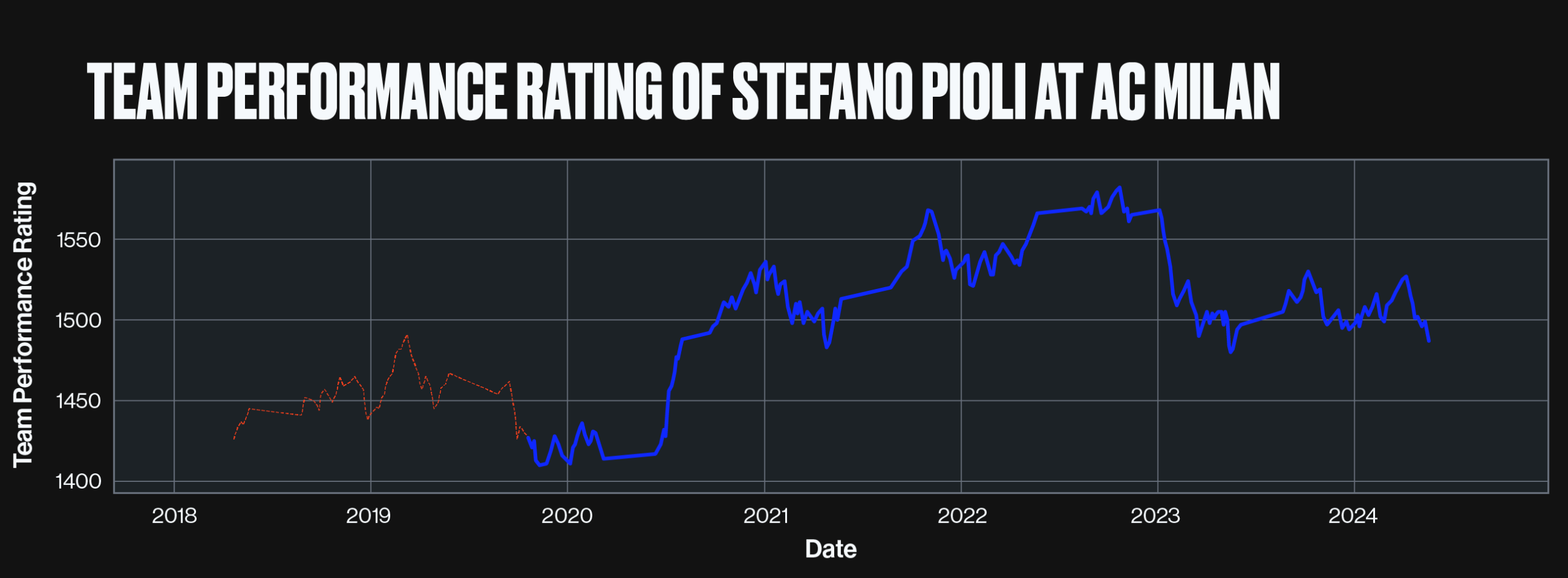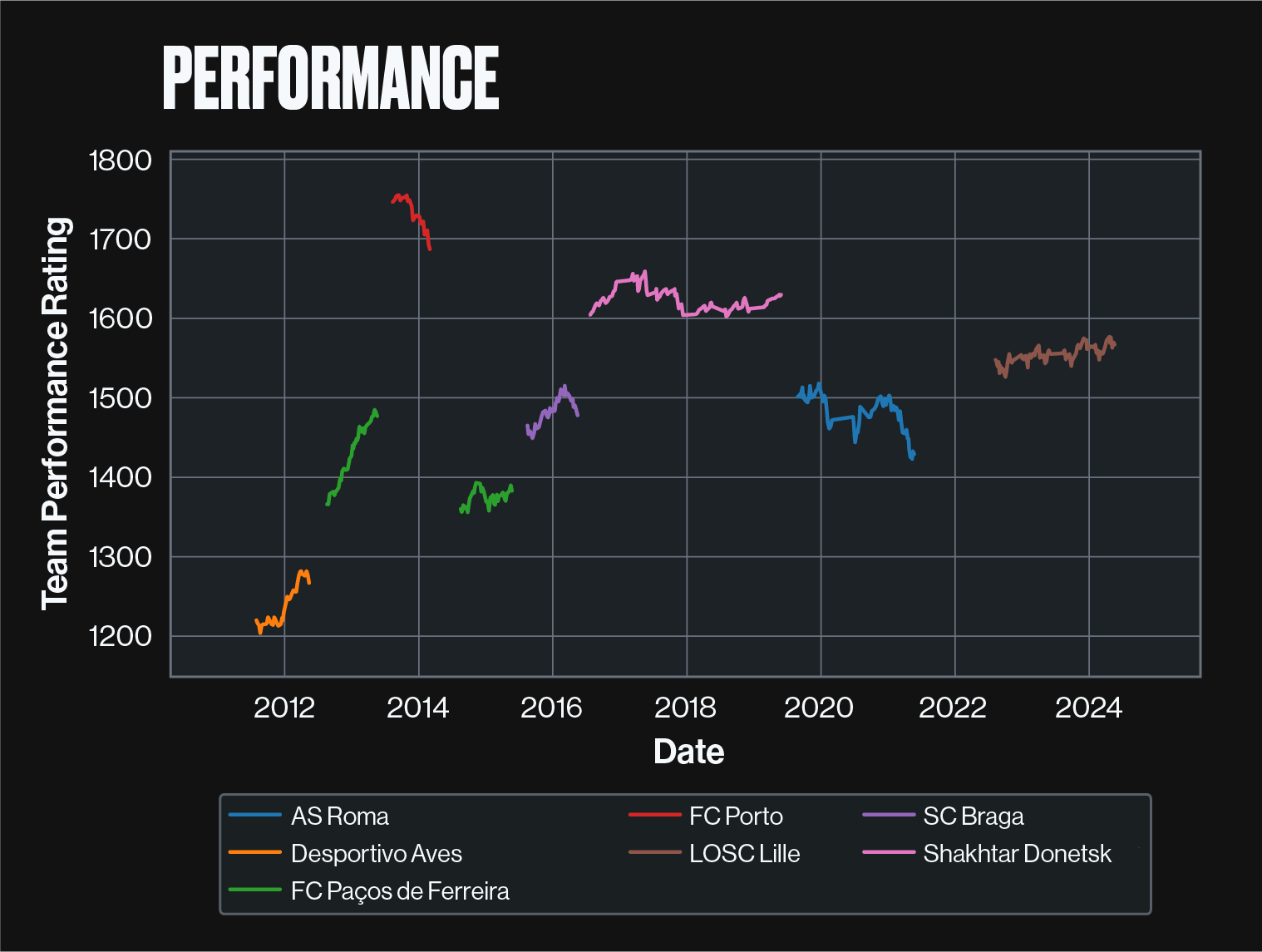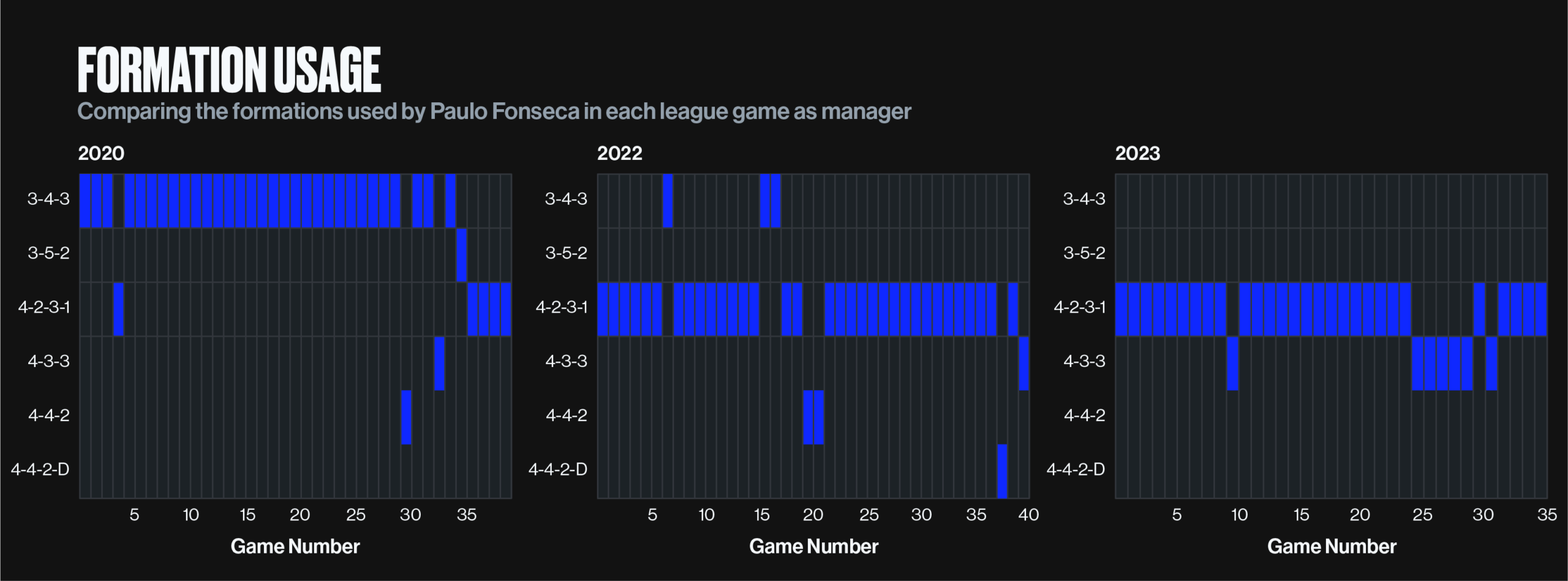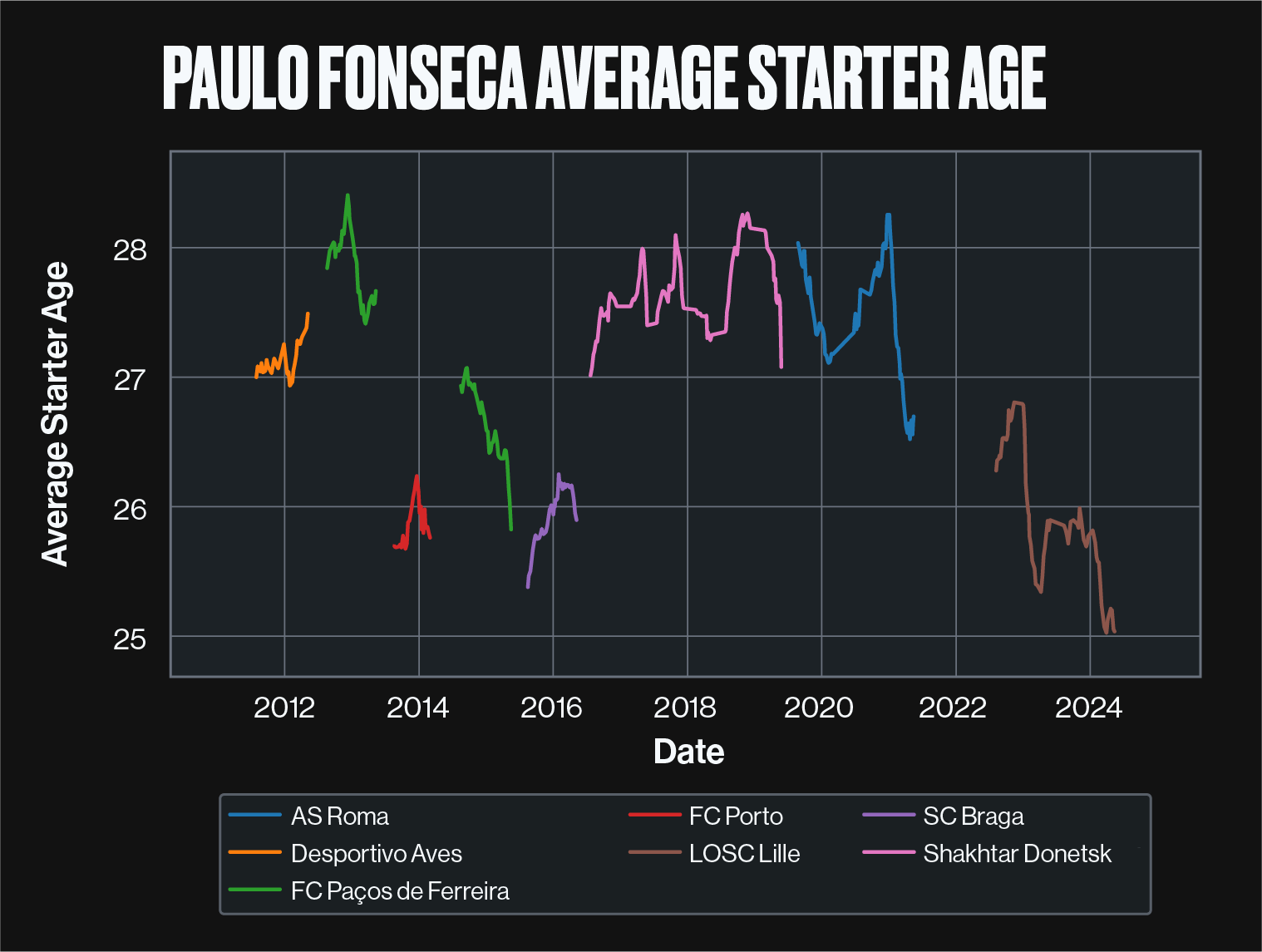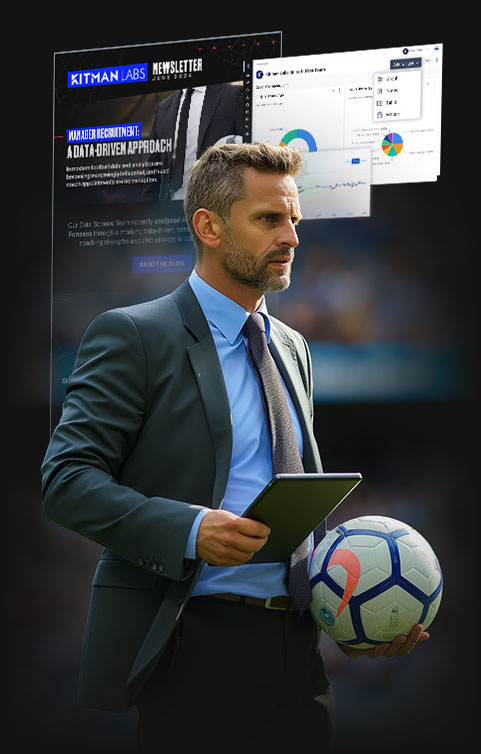Executive Summary
In the high-stakes world of elite soccer, the appointment of a head coach can make or break a club’s fortunes. Traditionally, clubs have relied on a mix of intuition, reputation, and past performance to select their leader in the dugout. However, in modern football data and analytics are becoming increasingly influential, and head coach appointments are no exception.
Recently, AC Milan appointed Paulo Fonseca as their new manager. As a case study for data-led manager evaluations, the Kitman Labs Data Science Team assessed Fonseca’s career – his playstyle and the results he achieved – to unlock some insights that speak to the potential strengths and weaknesses of the Portuguese manager in his new role.
- Formation and Tactical Consistency: Fonseca’s preferred 4-2-3-1 formation aligns with AC Milan’s recent setup. However, his reluctance to adapt tactics could be a potential weakness.
- Age Profile and Player Development: Fonseca tends to rely on experienced players in critical situations, which could be beneficial for AC Milan’s current squad reaching their peak.
- Past Performance and Stability: Fonseca has had mostly stable impacts on his teams, with some fluctuations early in his career. His tenure at AS Roma and FC Porto were less successful.
- Goals Scored vs. Conceded: Fonseca’s teams showed defensive improvement in his early career but had mixed results later. His formations and squad rotations indicate a tendency to maintain stability but change tactics after defeats.
Data-Led Manager Recruitment
Teams such as Brentford FC or FC Midtjylland are renowned for their “moneyball” approach to soccer, extensively employing data analysis to scout and recruit “hidden-gems” from all around the world that could be a great fit for their environments.
Similar approaches can be taken to identify the best candidates for the manager position as well. The goal is to go beyond mere win-loss records, delving into nuanced statistics that offer a deeper understanding of a coach’s tactical acumen, player development skills, and adaptability. Clubs might want to analyse detailed performance data from previous teams a coach has managed, assessing their ability to improve team performance, players’ market values or the club’s sustainability.
These cases highlight a broader trend: as with players scouting, the integration of data analytics into the manager recruitment process is not just about identifying successful coaches, but finding those whose strengths align with the club’s strategic vision. As data continues to shape the landscape of elite soccer, the role of analytics in head coach recruitment is poised to become even more pivotal, heralding a new era of informed decision-making in the sport.
Performance Assessment Methodology: Kitman Labs Performance Rating
- Kitman Labs has built a system to assess team performance derived from the well-known Elo rating system which originated in chess but is used to assess relative performance in many head-to-head sports.
- Our system is a way to rank teams within a group – league, country, continent, globally – measuring a team’s strength relative to all other teams within the group.
- When two teams compete in a match, the winner takes points from the loser.
- The amount of points exchanged depends on a range of factors, including the current rating of the team, the rating of their opponent, home field advantage, goal difference and the type of competition.
- When a stronger team plays a weaker team they will gain fewer points from a win than if the weaker team wins the matchup.
Case Study: Paulo Fonseca to AC Milan
Key Take-Home Insights
Analysing Fonseca’s career, his playstyle and the results he achieved, there are a number of interesting insights in relation to his new role with AC Milan:
Stability:
One of the first things that jump out is that Fonseca has mostly had quite solid impacts on his teams. The trajectories followed under his tenures were fairly stable, with a few highs and lows – especially at the beginning of his career. Pioli’s tenure has given back AC Milan the strength and the organisation to fight again for winning titles (at least at a domestic level). Having a manager that could guarantee to keep this level of performance even in the coming years could definitely be, therefore, the right choice in order to consolidate their rank in Italy.
Formation
- Fonseca’s preferred starting formation has so far been 4-2-3-1, which would guarantee continuity with how AC Milan have been set up in their most recent seasons. Fonseca does not seem to be a chameleonic manager that adapts to the next opponent. Rather he seems to have a clearly defined style which has usually given his teams enough stability to perform as expected, while rarely overperforming.
- Conversely, his lack of ability to change the system may be a possible pain point. Whenever he has diverged from his preferred formation the average goal difference in games decreased significantly, albeit this has been against stronger opposition on average. Moreover, his most regressive season was while in Italy where he tried to stick with the 3-4-3 formation without any success. His record lives on in the memory of Italian supporters, and this might mean some extra effort for Fonseca to convince them.
Age Profile
- For most of his career Fonseca has tended to rely on more experienced players, especially in difficult situations such as after a defeat or in games against strong opponents. AC Milan’s squad was renewed at the beginning of Pioli’s tenure in 2020. At the time it was one of the youngest teams of the entire Serie A. However many of their key players – Mike Maignan, Rafael Leāo, Theo Hernandez – are no longer at that “young and talented” stage and are reaching their peak. The data suggests Fonseca could be the one to empower these players to become true leaders and complete their maturation.
- The flipside can be in how AC Milan handles those established players: so far there has been a strict financial control which led some of the most valuable players – Donnarumma, Tonali, Kessiè, Calhanoglu – to leave the club, some of them even for free. Similarly their purchases in the transfer market have been characterised by players that came from lower tier clubs like Tonali himself, Maignan, and Reijnders; rising talents from top clubs like Brahim Diaz, and Tomori; or players that were coming out of difficult periods in their careers like Kjaer, Loftus-Cheek, and Pulisic. If the direction for the upcoming transfer window is the same, and there are “rumours” of Theo Hernandez and possibly Leao leaving the club, would Fonseca be able to forge new leaders as Pioli did?
Overall Fonseca Past Performance
| Team | Season | Number of Games | Start Elo | End Elo | Performance Impact |
| Desportivo Aves | 2011-12 | 34 | 1214 | 1267 | 53 |
| FC Paços de Ferreira | 2012-13 | 40 | 1371 | 1477 | 106 |
| Porto FC | 2013-14 | 29 | 1745 | 1687 | -58 |
| FC Paços de Ferreira | 2014-15 | 36 | 1362 | 1382 | 21 |
| SC Braga | 2015-16 | 44 | 1458 | 1478 | 20 |
| Shakhtar Donetsk | 2016-17 | 36 | 1603 | 1629 | 26 |
| Shakhtar Donetsk | 2017-18 | 37 | 1629 | 1615 | -14 |
| Shakhtar Donetsk | 2018-19 | 36 | 1615 | 1630 | 15 |
| AS Roma | 2019-20 | 40 | 1508 | 1489 | -19 |
| AS Roma | 2020-21 | 39 | 1489 | 1429 | -60 |
| LOSC Lille | 2022-23 | 40 | 1544 | 1555 | 11 |
| LOSC Lille | 2023-24 | 35 | 1555 | 1567 | 12 |
Fonseca started his career really well with 2 progressive seasons – seasons where he left the team much stronger than when he took over – having highly positive impacts on Desportivo Aves and Paços de Ferreira. After this great beginning he settled into a mostly neutral position, with a couple of negative seasons – 2013-14 (Porto FC) and 2020-21 (AS Roma) – where the team deteriorated under his charge. Except for these two experiences, however, his impact on a new team is usually quite solid, generally leading to moderate performance improvements.
Goals Scored vs Goals Conceded
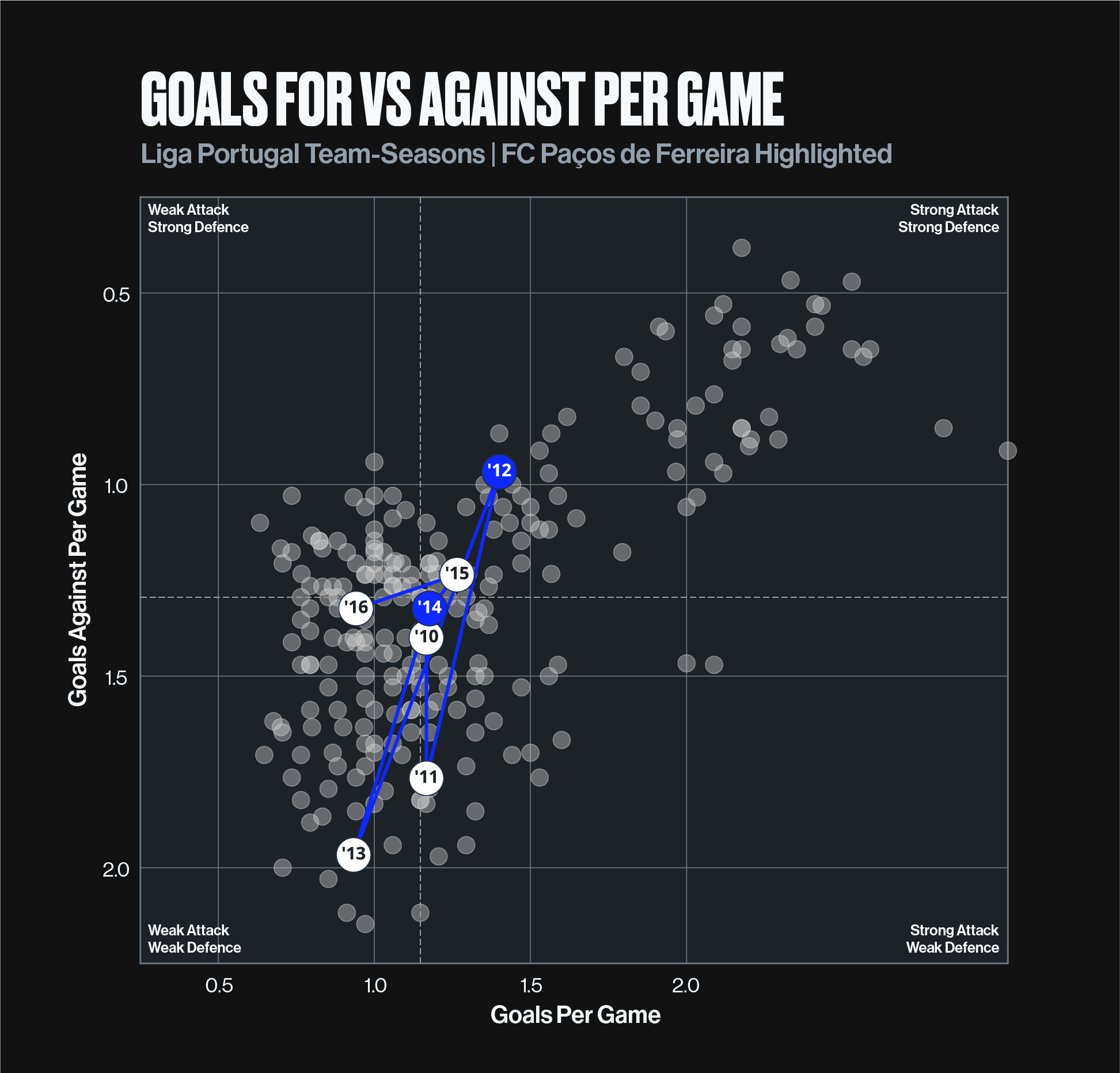 |
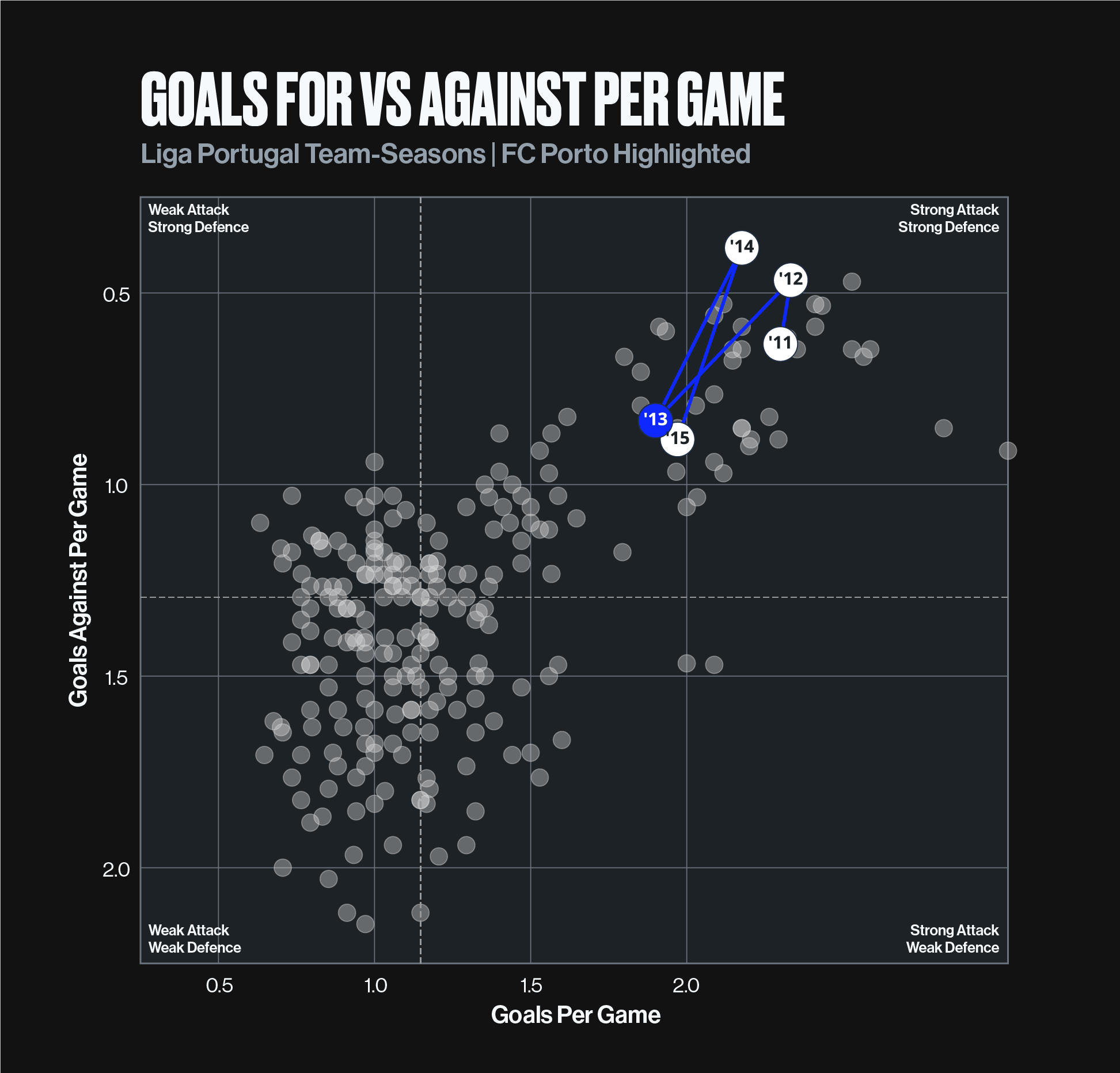 |
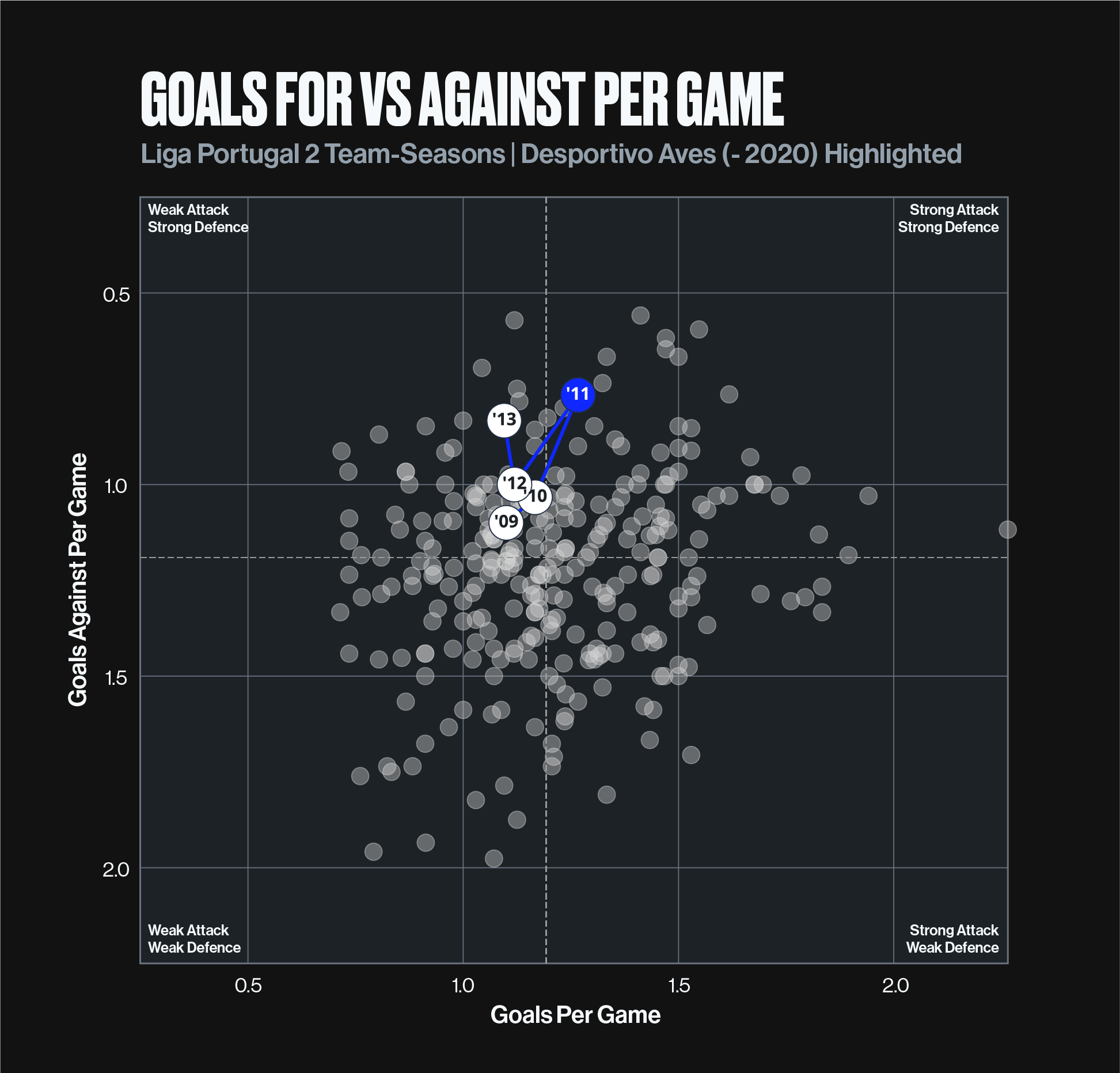 |
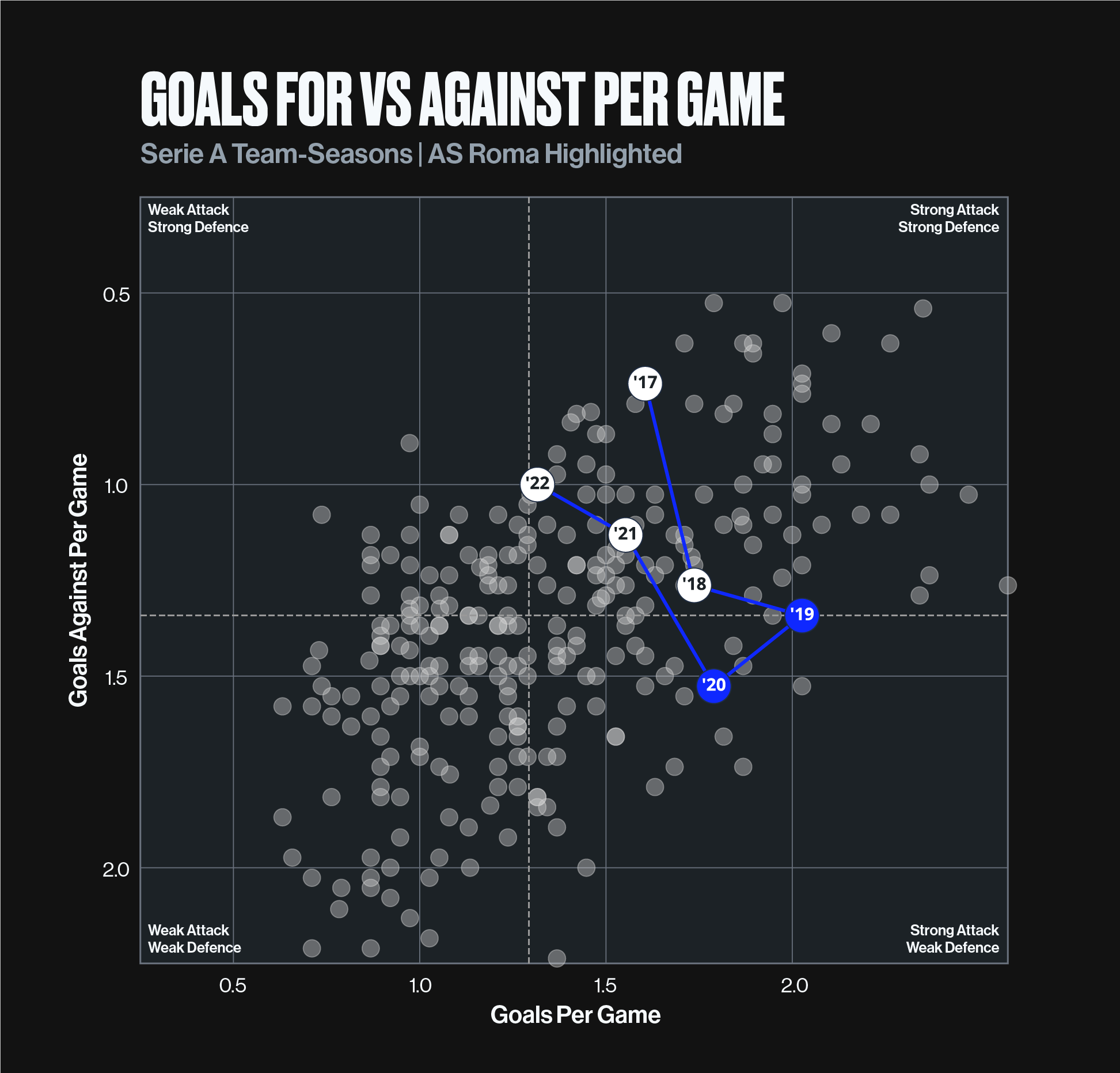 |
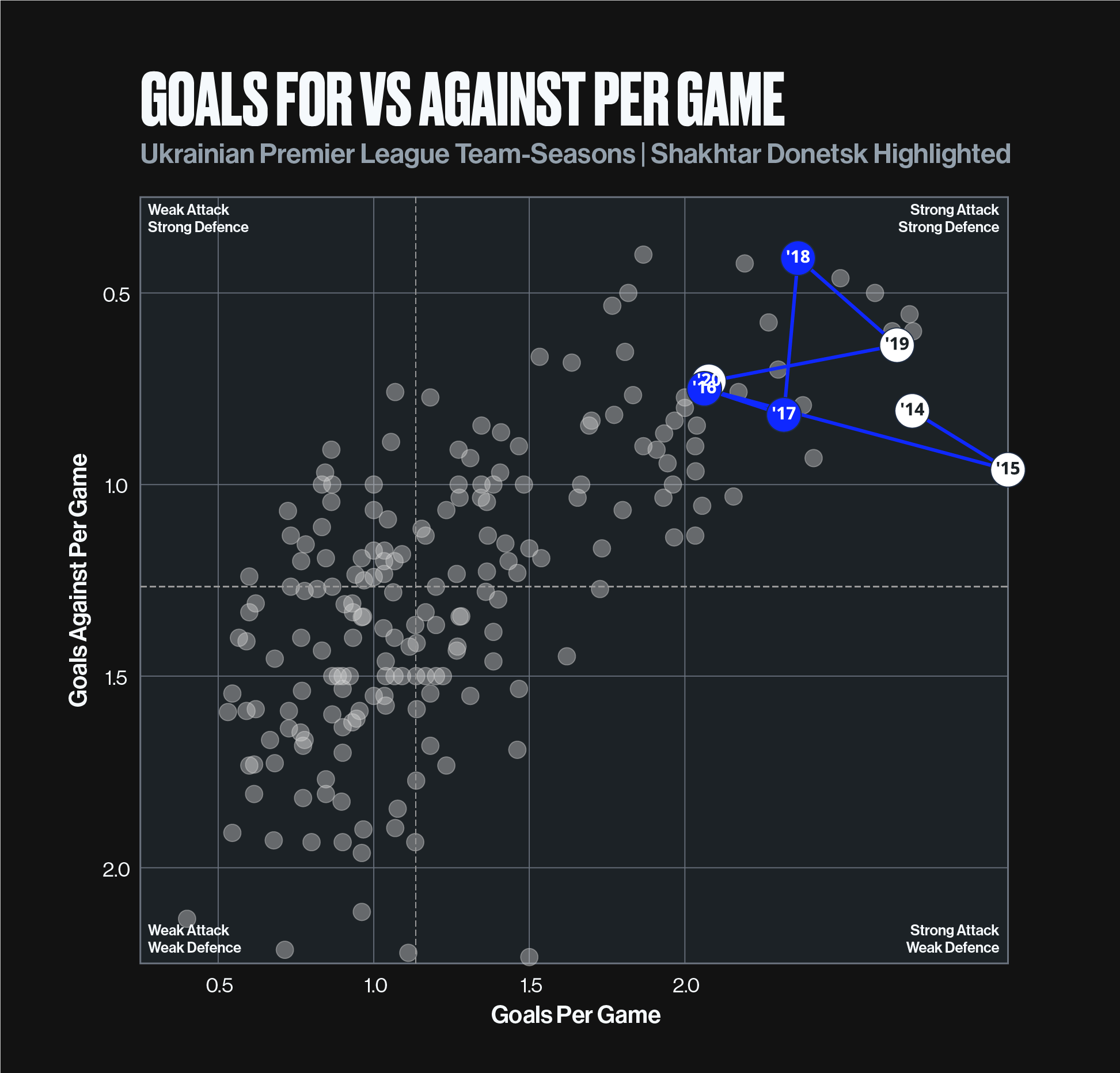 |
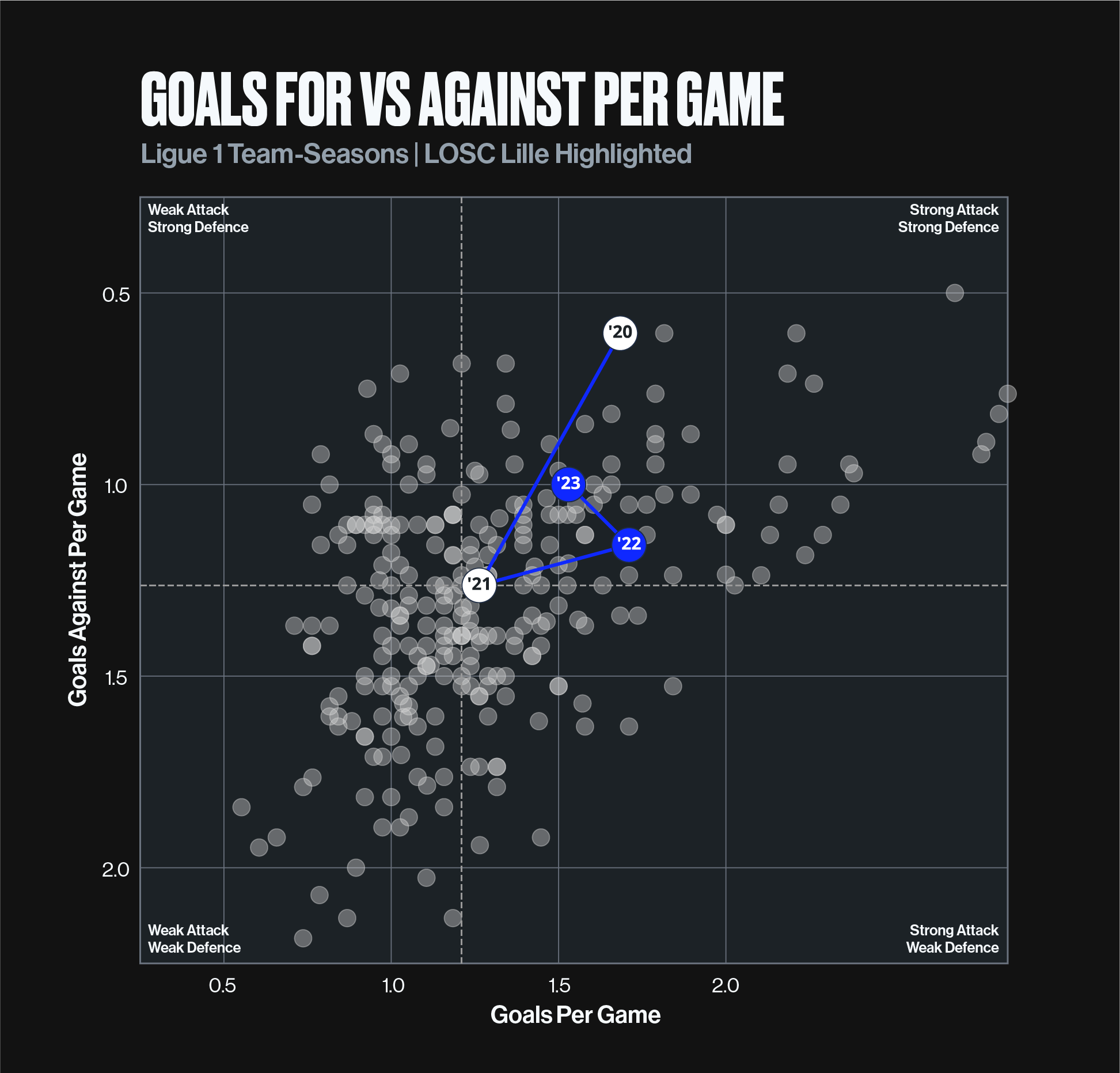 |
By looking at goals scored vs goals conceded, it can be seen how Fonseca was able at the early stages of his career to significantly improve the defensive side of his teams during his tenures. In particular with Paços de Ferreira where he was able to bring the team from an average to an above-average performance in 2012-13 and from a highly below average to an average performance in 2014-15. During those neutral seasons with Braga, Shaktar and Lille he maintained consistency with the previous seasons. It was only during his regressive seasons with FC Porto (2013-14) and AS Roma (2020-21) that performances deteriorated in both attack and defence.
Market Value
| Team | Season | League | Market Value Rank | Table Position |
| Desportivo Aves | 2011-12 | POR 2 | 4th | 3rd |
| FC Paços de Ferreira | 2012-13 | POR 1 | 6th | 3rd |
| Porto FC | 2013-14 | POR 1 | 1st | 3rd |
| FC Paços de Ferreira | 2014-15 | POR 1 | 12th | 8th |
| SC Braga | 2015-16 | POR 1 | 4th | 4th |
| Shakhtar Donetsk | 2016-17 | UKR 1 | 1st | 1st |
| Shakhtar Donetsk | 2017-18 | UKR 1 | 1st | 1st |
| Shakhtar Donetsk | 2018-19 | UKR 1 | 1st | 1st |
| AS Roma | 2019-20 | IT 1 | 6th | 5th |
| AS Roma | 2020-21 | IT 1 | 7th | 7th |
| LOSC Lille | 2022-23 | FR 1 | 6th | 5th |
| LOSC Lille | 2023-24 | FR 1 | 3rd | 4th |
Compared to the overall market value (see above) of the teams in his charge, Fonseca generally gets the expected results. The most that any of his teams overperformed was during the Paços de Ferreira tenures, while the largest underperformance was probably at FC Porto.
Starting Formation Analysis
| Formation | Used | Average Rating Difference (Current Rating – Opp. Rating) |
Average Goal Difference |
| 4-2-3-1 | 234 | 213.06 | 1.107 |
| 4-4-2 | 89 | 46.404 | 0.348 |
| 3-4-3 | 43 | 127.86 | 0.326 |
| 4-3-3 | 25 | 186.64 | 0.72 |
| 4-4-2 Diamond | 2 | -47.5 | 0.5 |
| 3-5-2 | 2 | 38.5 | -1.5 |
Average Rating Difference is the difference between his team’s current rating and the opposition. Fonseca’s most successful and most frequently used formation is the 4-2-3-1, deploying this starting formation far and above any other, while his second favourite is 4-4-2. The data shows that he tends to reach for this formation when up against stronger, or at least comparable, opponents. In terms of consistency, he often sticks with the same starting formations for extended periods. His second season with AS Roma in 2020-2021 is interesting, where he consistently selected the 3-4-3 as formation, although the overall results in terms of performance were not completely positive.
Squad Rotation
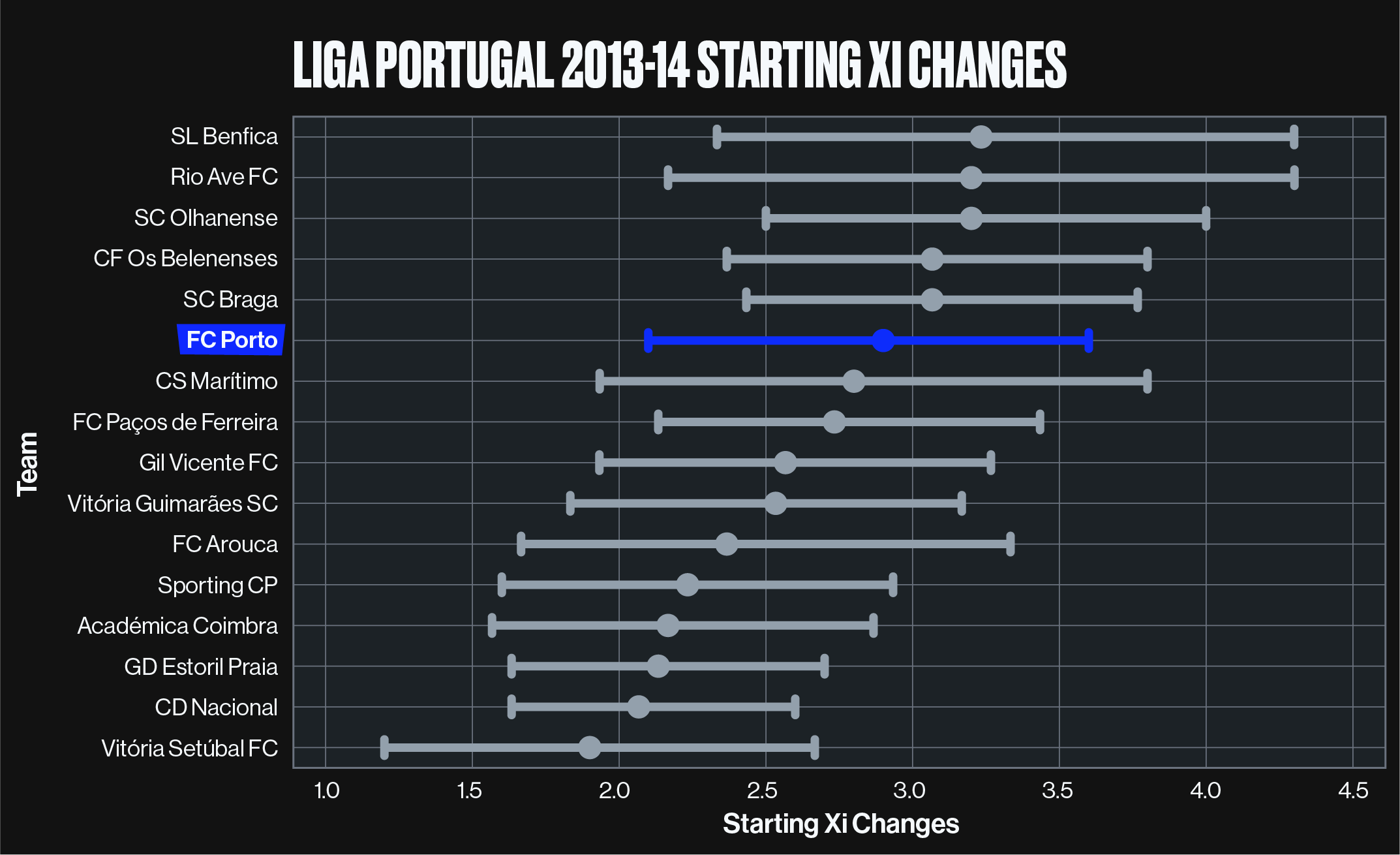 |
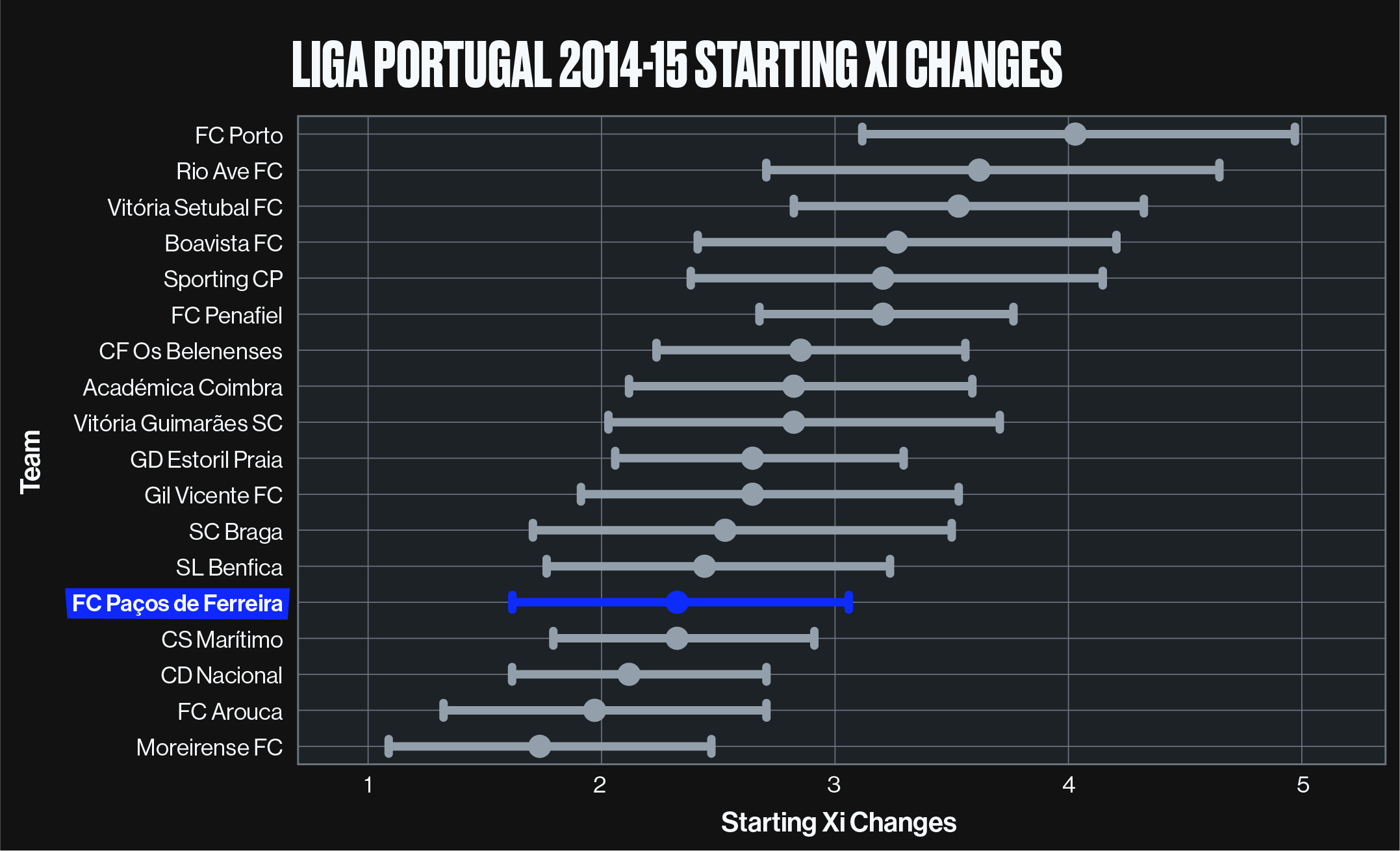 |
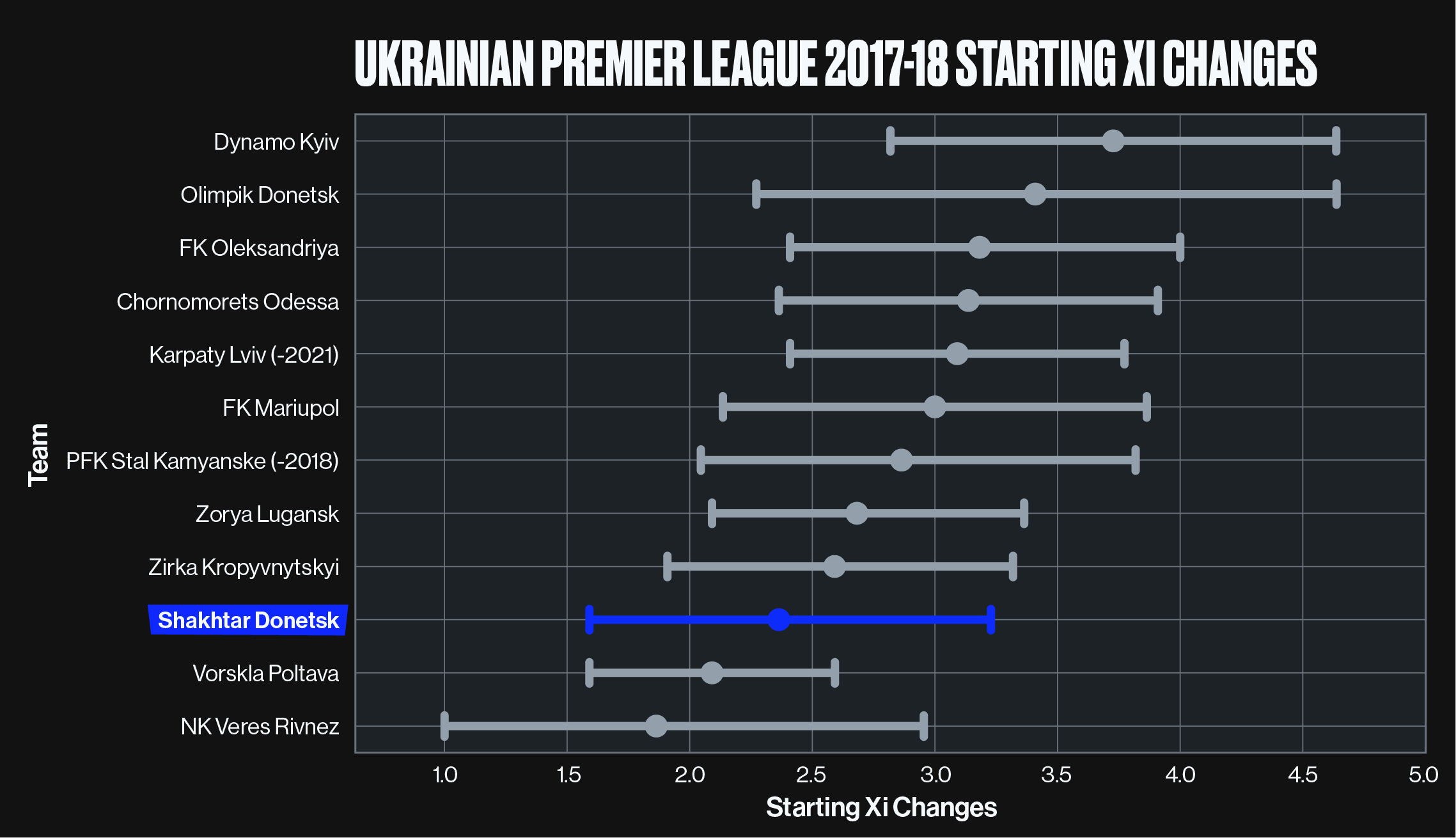 |
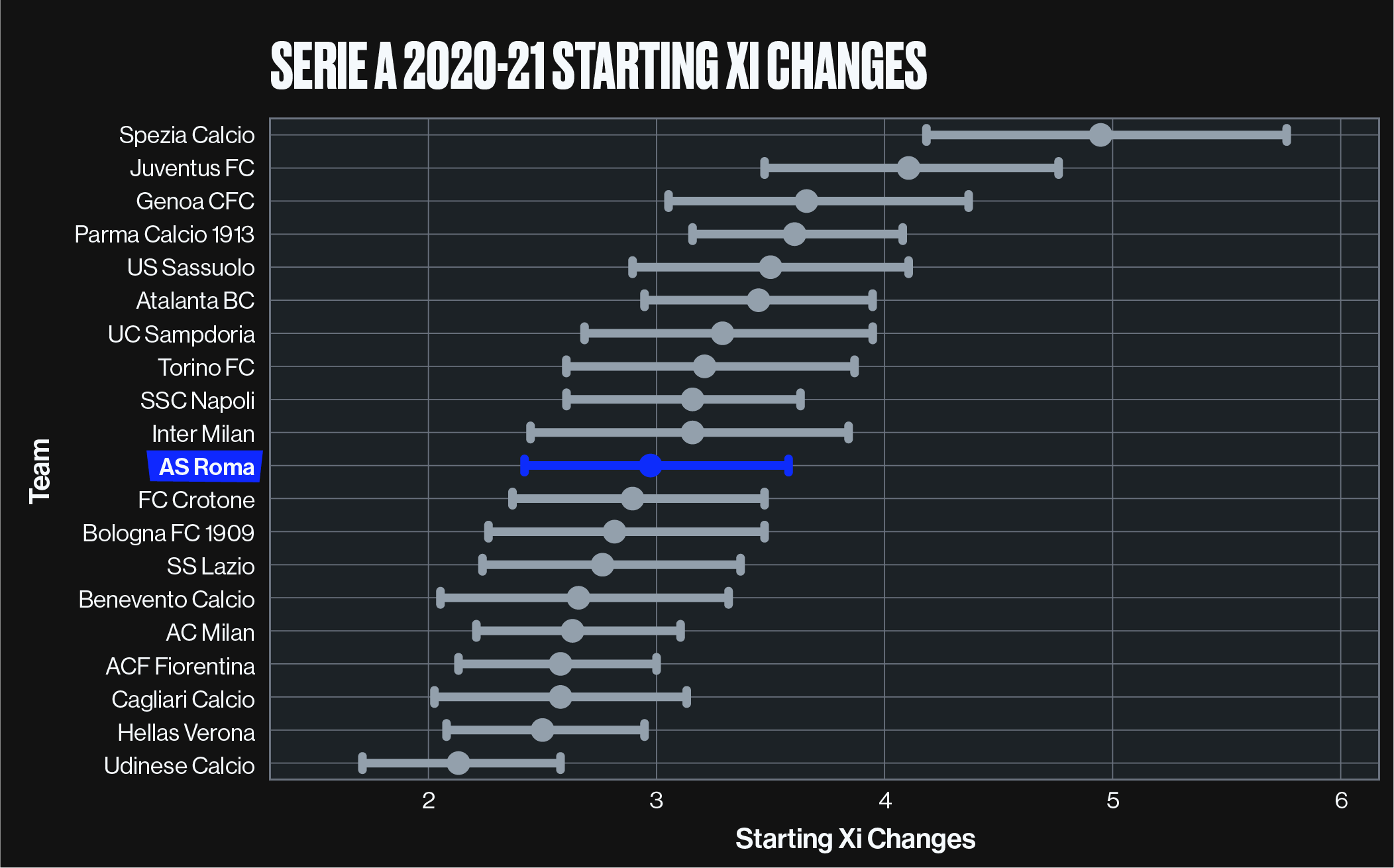 |
During Fonseca’s most successful seasons he tended to maintain stability in his starting line-ups, with on average around two changes to the starting XI. However during his regressive seasons with FC Porto and AS Roma he changed the starting line-ups more often, possibly indicating some issues in finding the key for success.
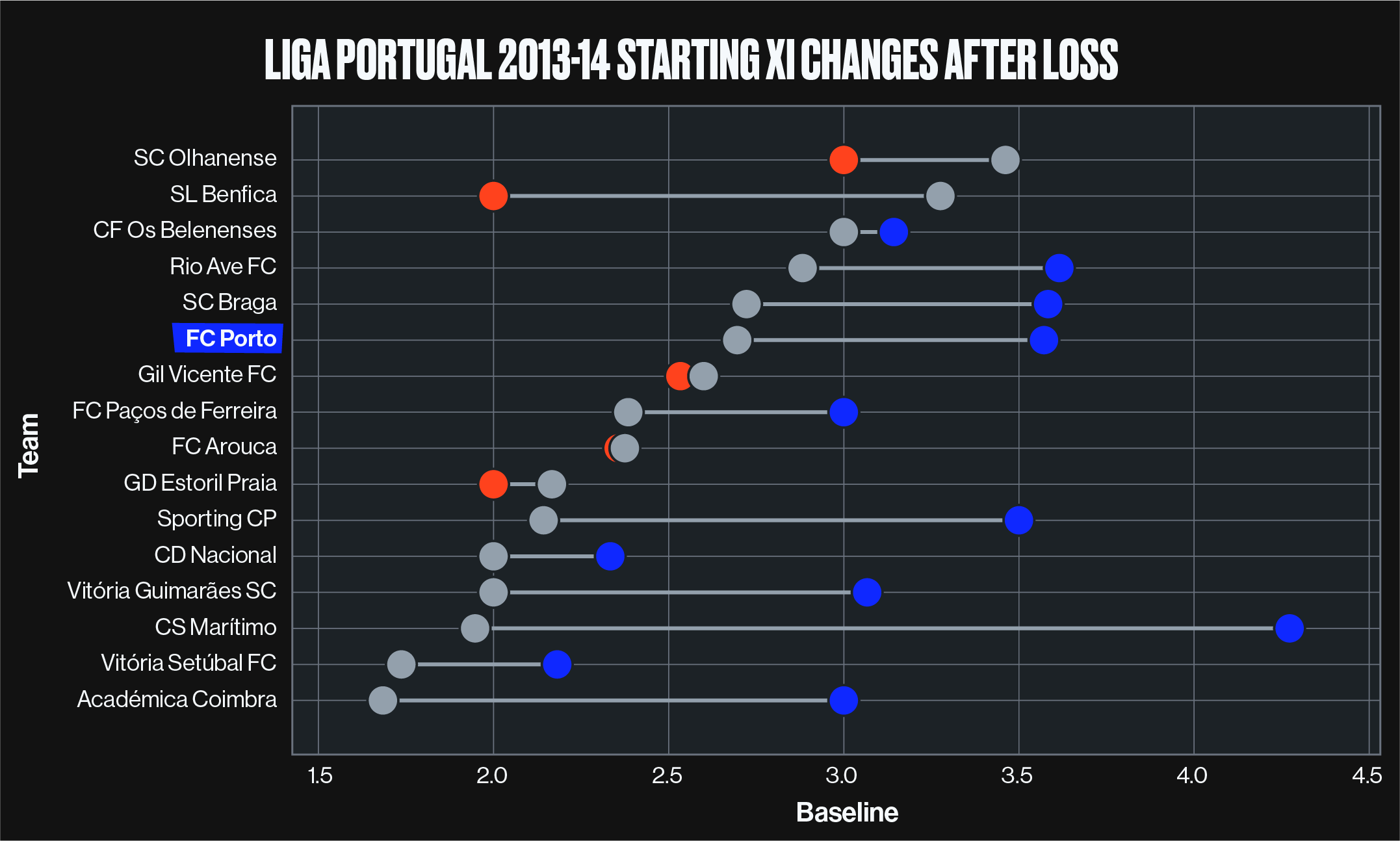 |
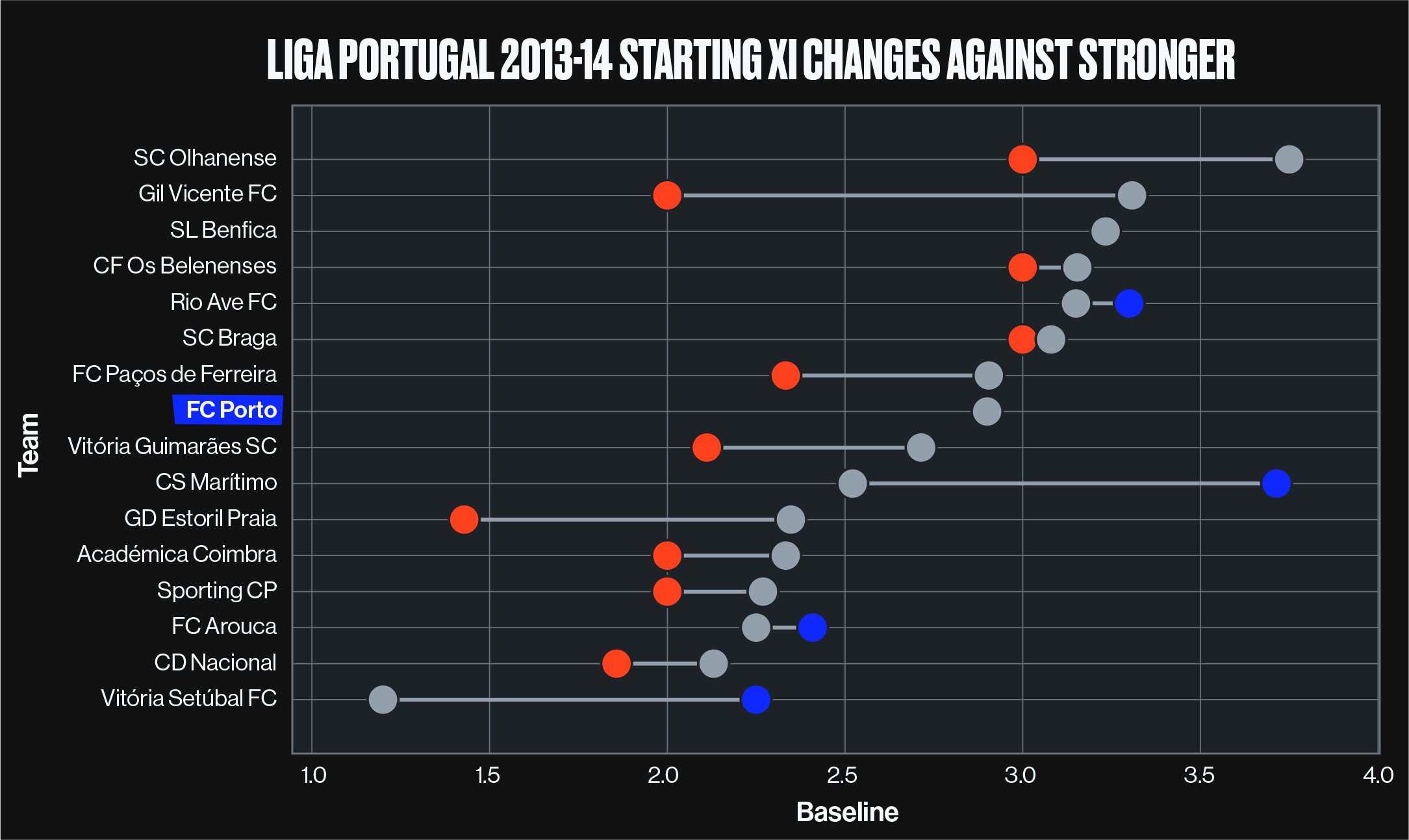 |
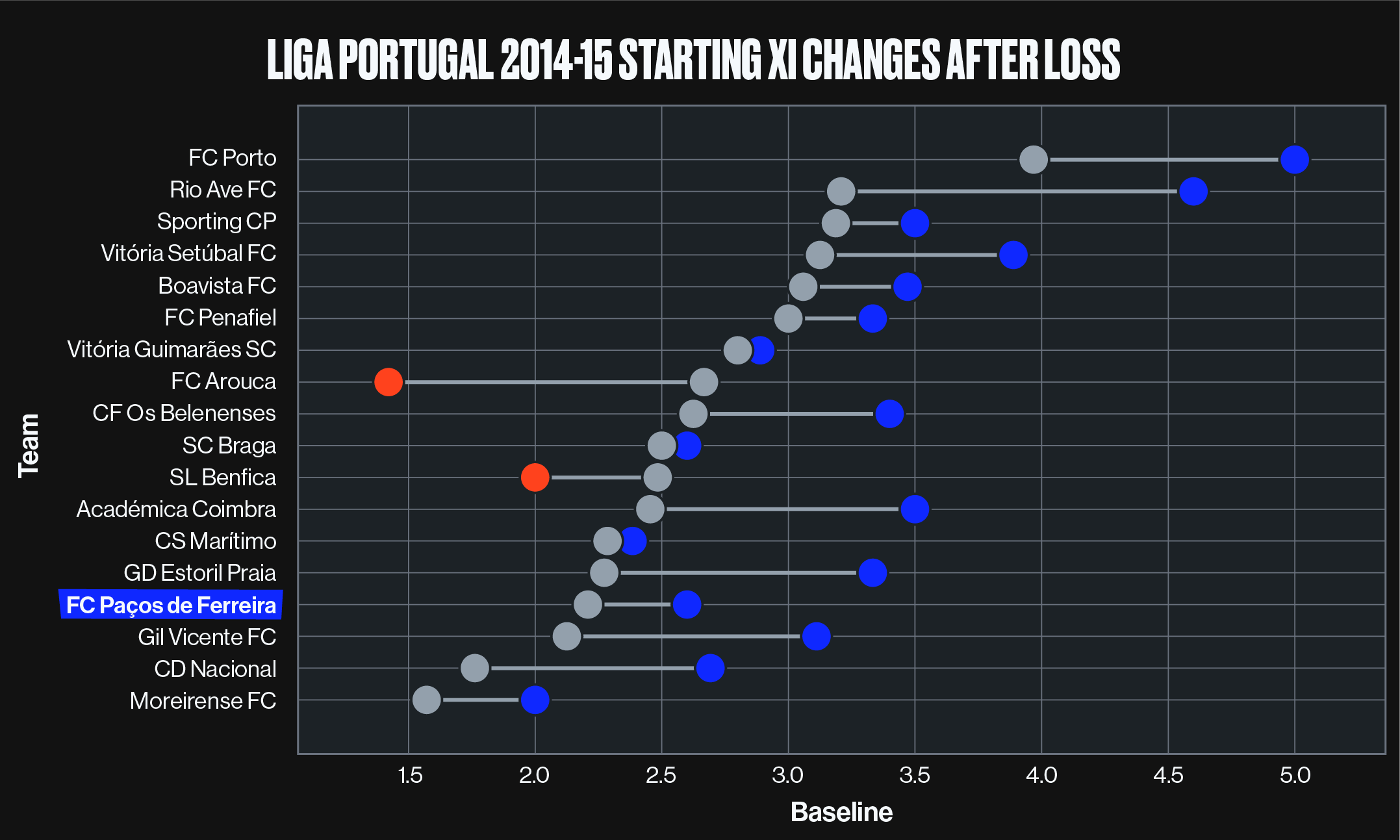 |
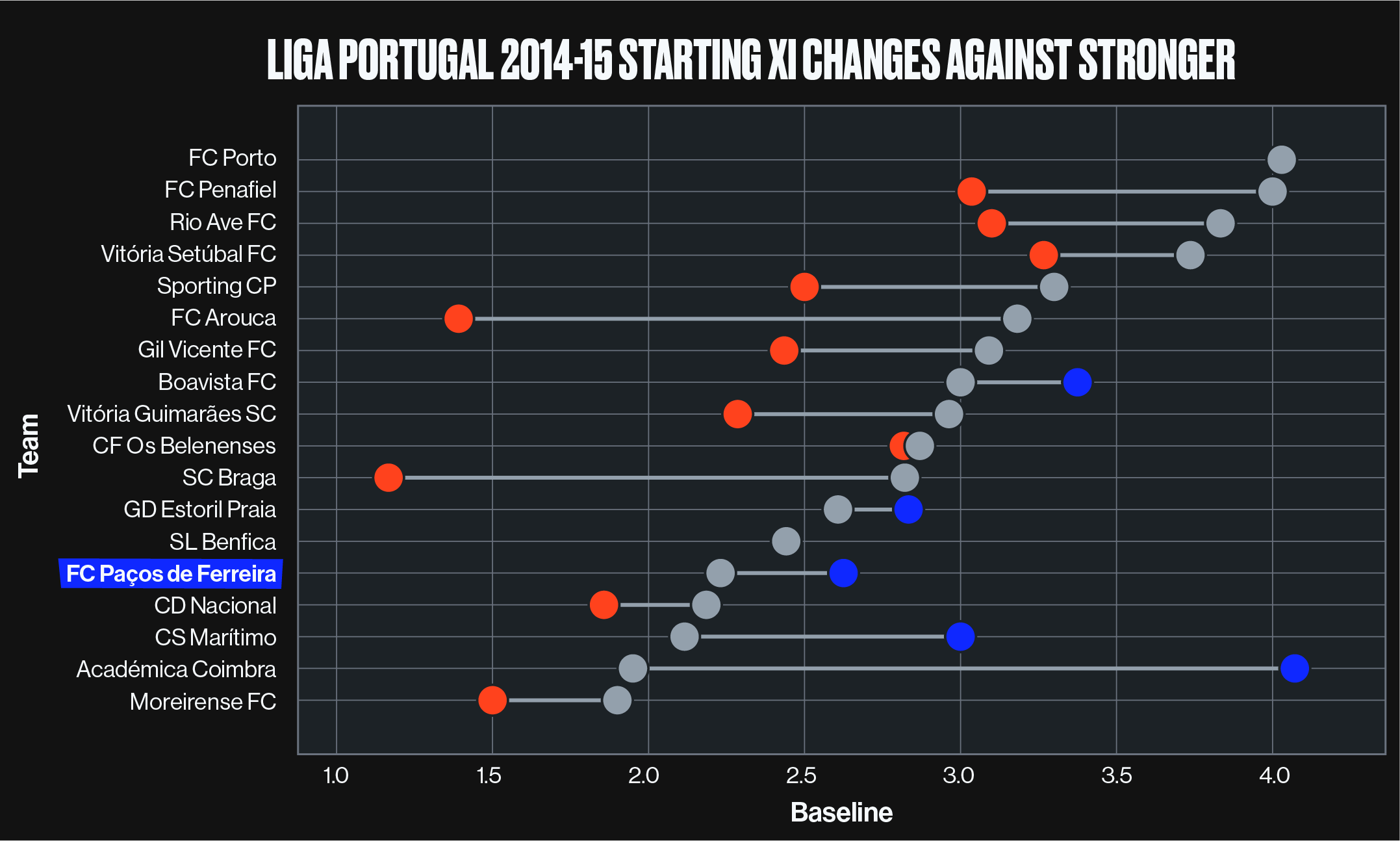 |
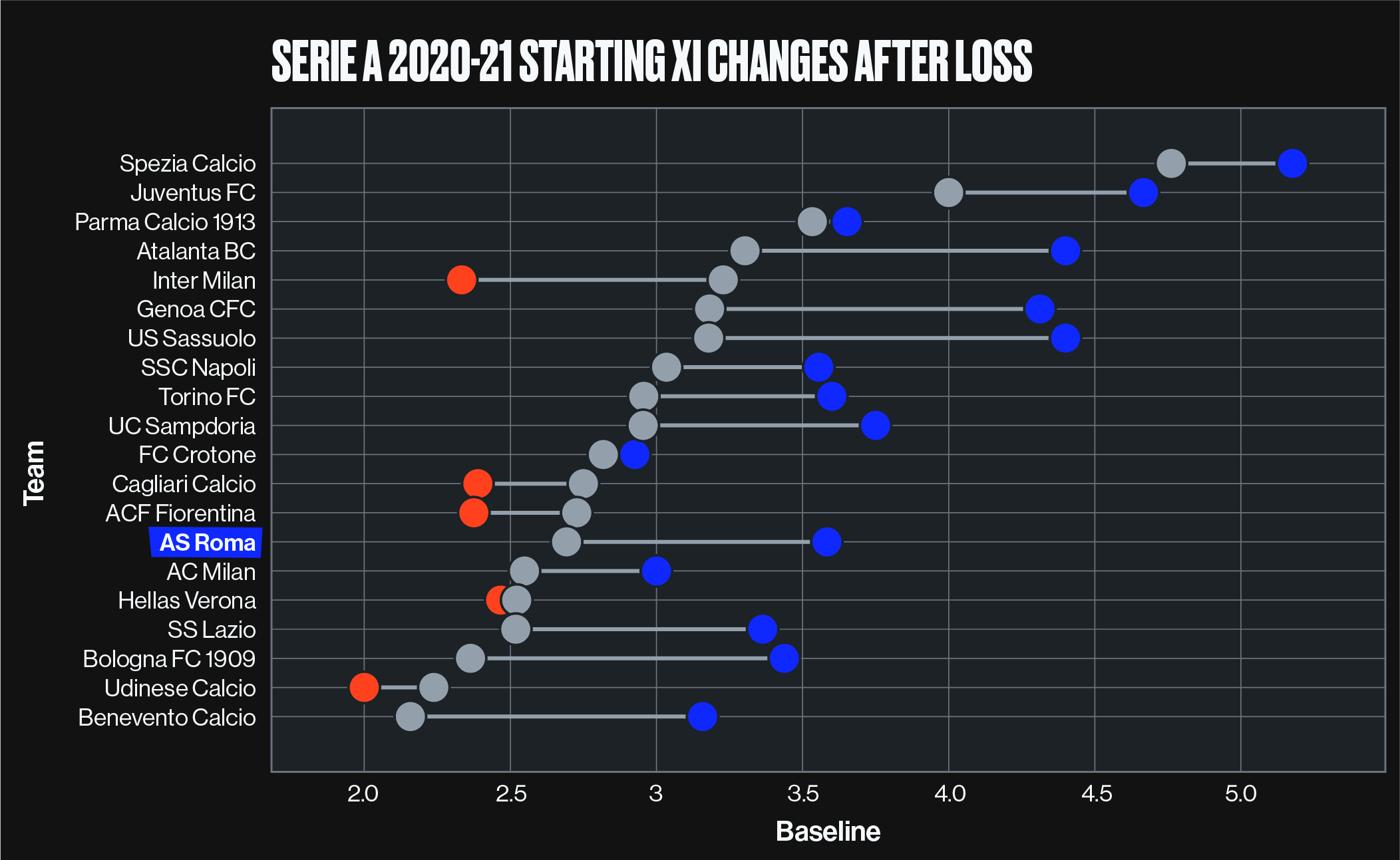 |
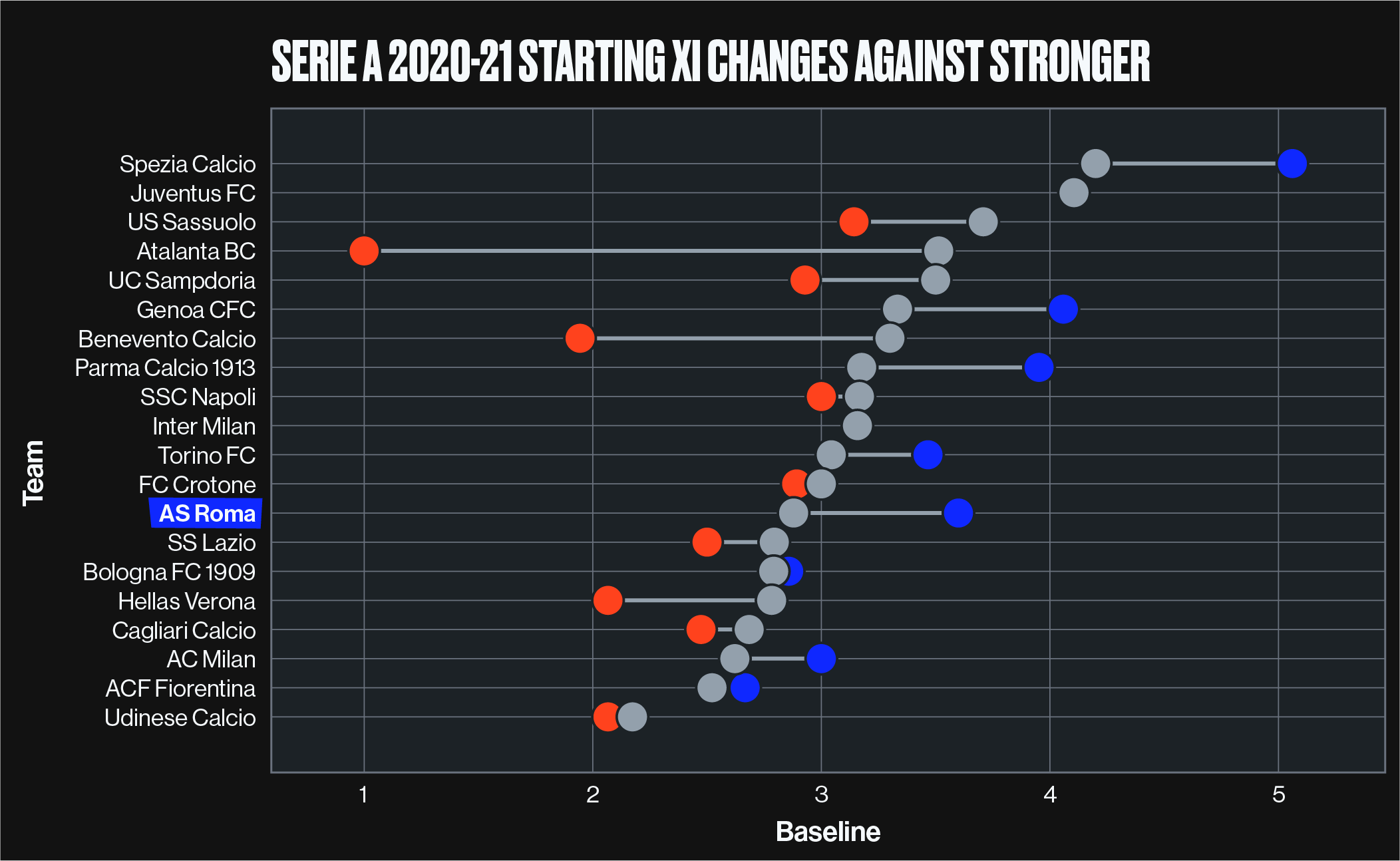 |
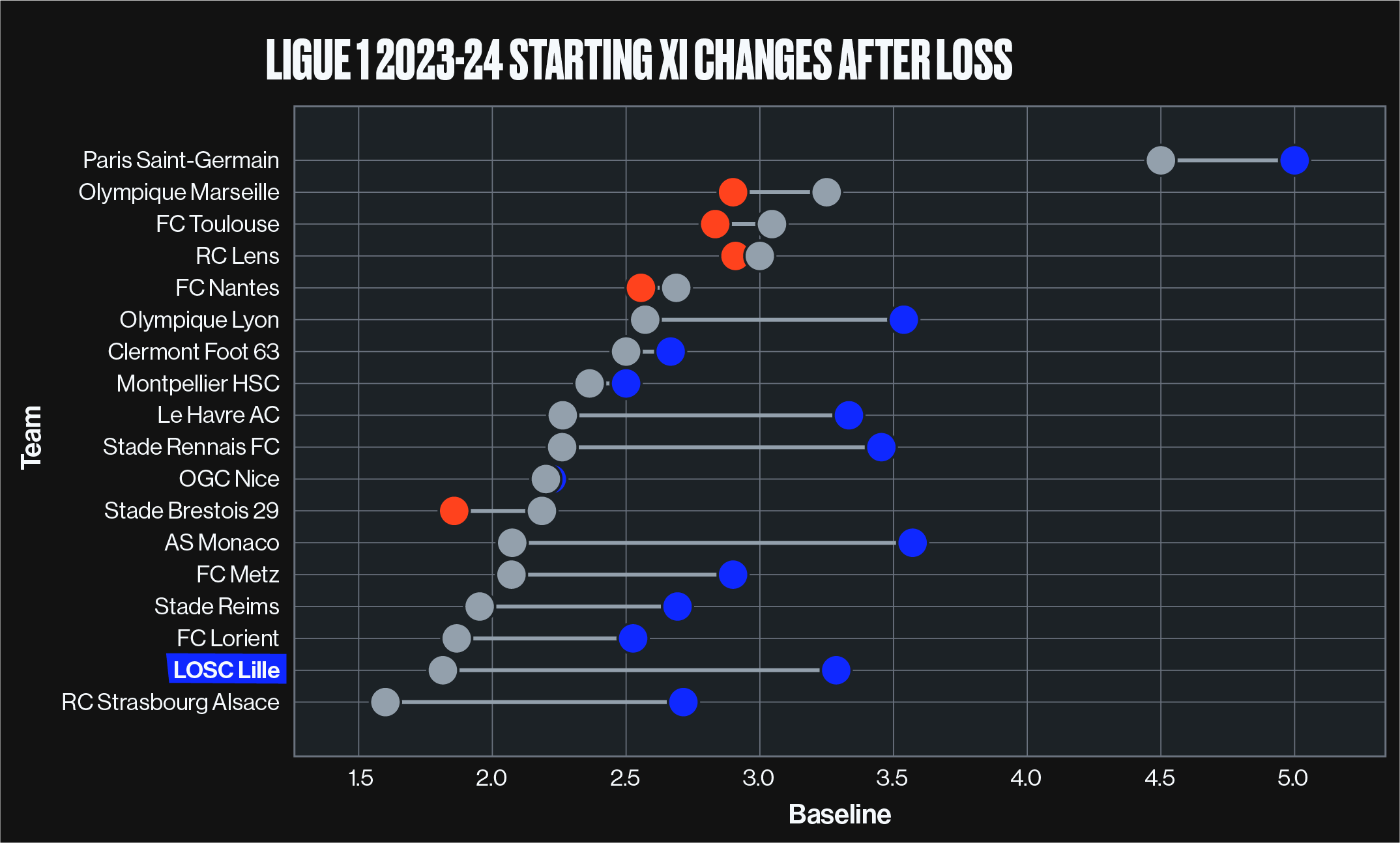 |
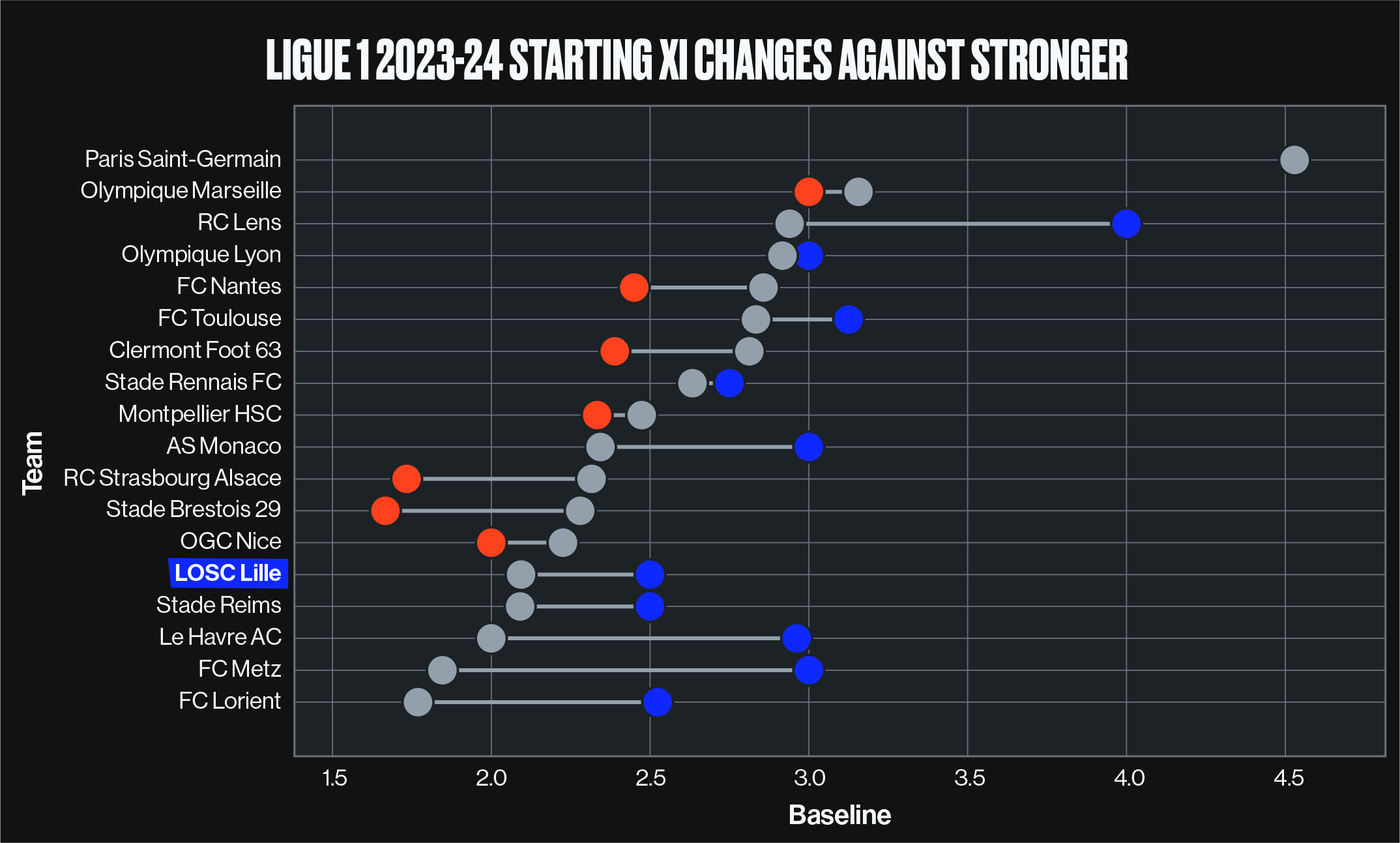 |
In the above series of graphs we can see how Fonseca’s starting XI changes after a loss (left column) and against stronger opponents (right column). Each chart has on the x-axis the number of starting XI changes and on the y-axis the league teams, ranked by average number of starting XI changes (grey dots). The blue/red dots represent the average number of changes after a loss (left) or against a stronger opponent (right). When a dot is red, it means that in those situations the manager makes fewer changes than usual, while when a dot is Blue it means the number of changes is greater than usual. We can therefore infer from the above that despite having a generally stable formation, with fewer changes if compared to the other teams in the same league, Fonseca’s rotations tended to happen more straight after a defeat, or against stronger opponents. Interestingly, this can be seen both in his most successful and least successful seasons.
Age Profile
Looking at the age profile of Fonseca’s starting XI, the data shows that all of his tenures, except his time at AS Roma, started with an increase in the average starter age. Up until his experience in Italy, his most successful seasons (2011-12, 2012-13, 2016-2019) coincide with a higher average age for his starting XI. During the seasons with FC Porto and SC Braga the average starter age was as low as around 26. Of late this trend seems inverted, with Lille being able to secure a spot in the Champions League during season 2023-24, while having the fifth youngest starting XI on average. However, looking more closely, we see that Fonseca still tends to rely on more experienced players when it comes to facing stronger opponents, or when he needs the team to get back on track after a loss.
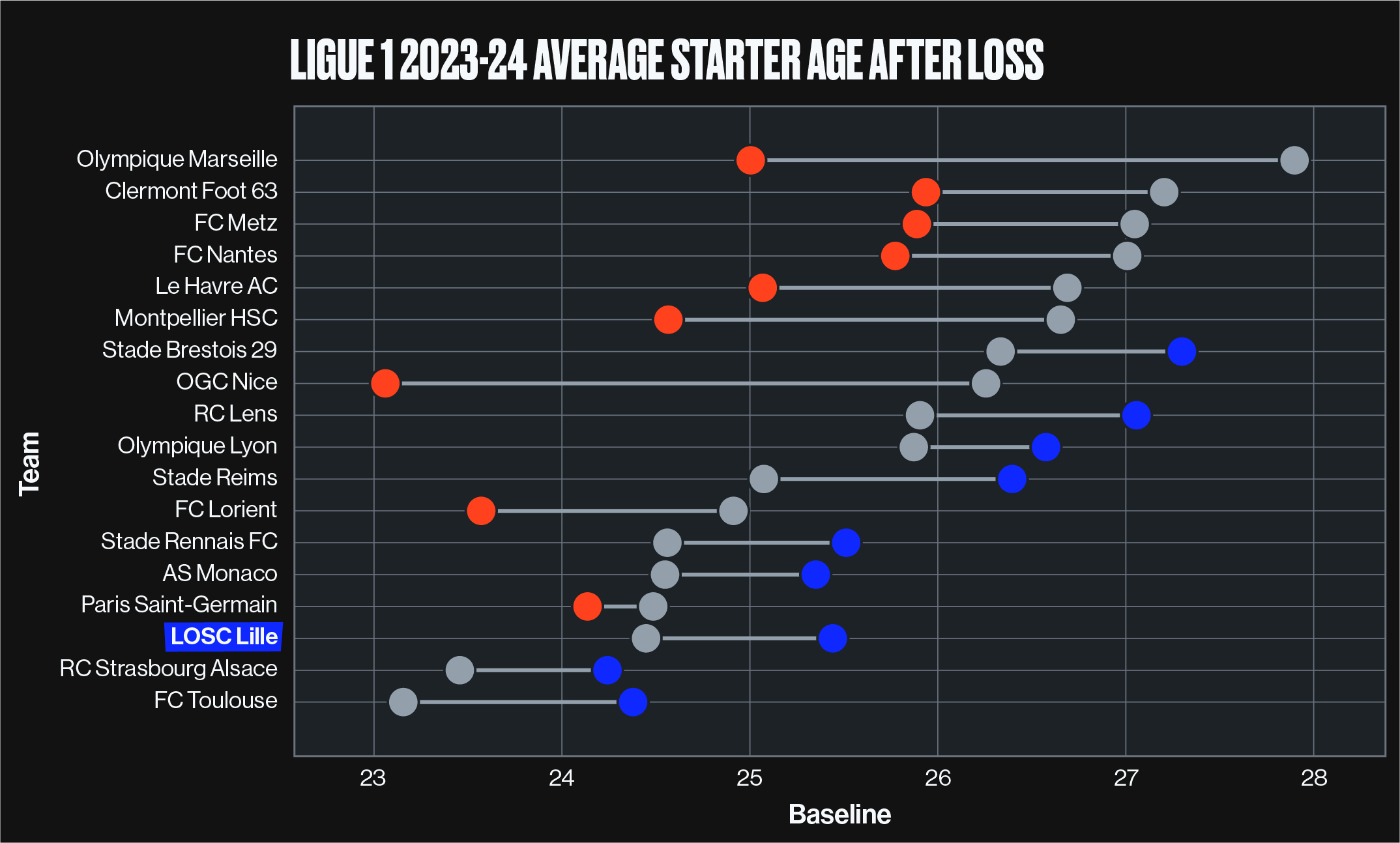 |
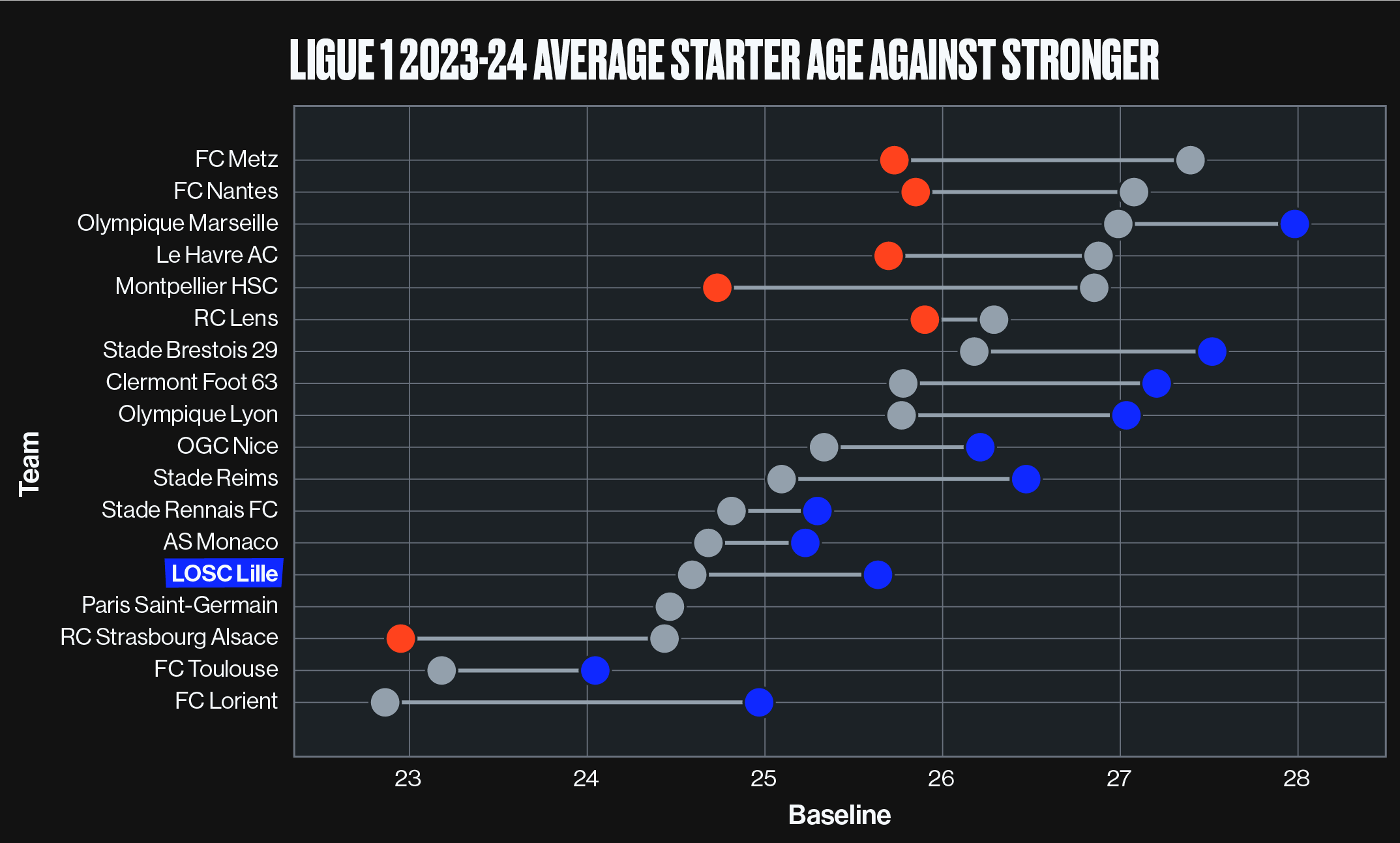 |
CONCLUSION
The manager of a football club is arguably the most important member of staff. They drive the culture, philosophies and ultimately have the largest influence on the team’s chances of being successful. Getting the right person for this role is critical to the success of the organization. However, what we often see in the world’s largest sports is that teams are not currently hiring well for this position and many managers move on in less than a year. Bringing objectivity into this critical decision via data and analytics is vital for the world’s top clubs.
If you are interested in hearing more about how Kitman Labs Custom Analytics can help your team or organisation, contact our Performance Experts today.
